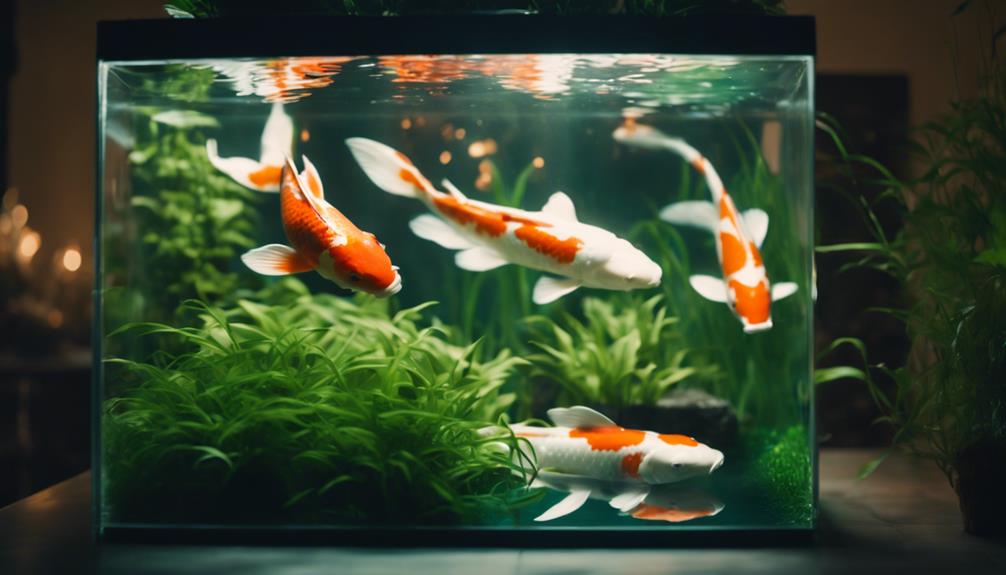You'll need to create a controlled environment for indoor koi breeding, with precise temperature, water quality, and lighting parameters. Dedicate a spacious tank with at least 10 gallons of water per koi, and provide adequate hiding places to reduce stress. Maintain clean, gently circulated water with a reliable filtration system. Select healthy, 3-6 year old koi with excellent body conformation and vibrant colors. Guarantee a balanced diet, and monitor water quality, making adjustments as needed. Manage the breeding process with care, and be patient – with precise control, you'll increase your chances of success. Now, fine-tune your approach…
Table of Contents
Key Takeaways
- Establish a controlled breeding space with precise temperature, water quality, and lighting parameters to encourage successful spawning.
- Select healthy, disease-free koi fish that are at least 3-6 years old, with excellent body conformation, vibrant colors, and a strong immune system.
- Implement a reliable water filtration system that efficiently removes waste products and excess nutrients, and maintain a clean and gently circulated water environment.
- Provide a balanced diet that meets koi fish's nutritional requirements for peak health and reproductive performance, and consider adding supplements to enhance breeding.
- Monitor water quality, koi health, and breeding progress regularly, keeping accurate records to track progress and inform data-driven decisions.
Prepare a Suitable Breeding Environment
Setting up a suitable breeding environment involves creating a controlled space that mimics the ideal conditions for koi reproduction, with precise temperature, water quality, and lighting parameters.
You'll want to establish a good environment that encourages healthy growth and spawning. Start by setting up a reliable filtration system to maintain clean water, which is essential for koi reproduction.
Certify the water is gently aerated using an Air Pump to provide adequate oxygen levels. Next, create a spawning area by adding spawning ropes or other breeding aids to stimulate spawning.
You'll also need to control the water temperature, ideally between 65°F to 75°F, and provide adequate lighting, but avoid direct sunlight.
Choose Healthy Koi Fish for Breeding
When selecting koi fish for breeding, you'll want to choose individuals that meet specific criteria to guarantee healthy and successful reproduction.
Make sure to select koi fish that are at least 3 to 6 years old, as they're more likely to mate and reproduce successfully.
Identify Male and Female koi fish by their physical characteristics: males have slender shapes and defined fins near the head, while females have rounder shapes and less defined fins.
Certify the koi fish are healthy and free of diseases before breeding by monitoring their appetite, energy level, and overall appearance.
Choose koi fish with excellent body conformation, vibrant colors, and a strong immune system to increase the chances of producing healthy and high-quality offspring.
Remove koi fish that aren't intended for breeding to prevent unwanted offspring and maintain a healthy and controlled breeding environment.
It's a good idea to only breed well-fed and healthy fish to certify the whole process goes smoothly.
Provide Ample Space and Privacy
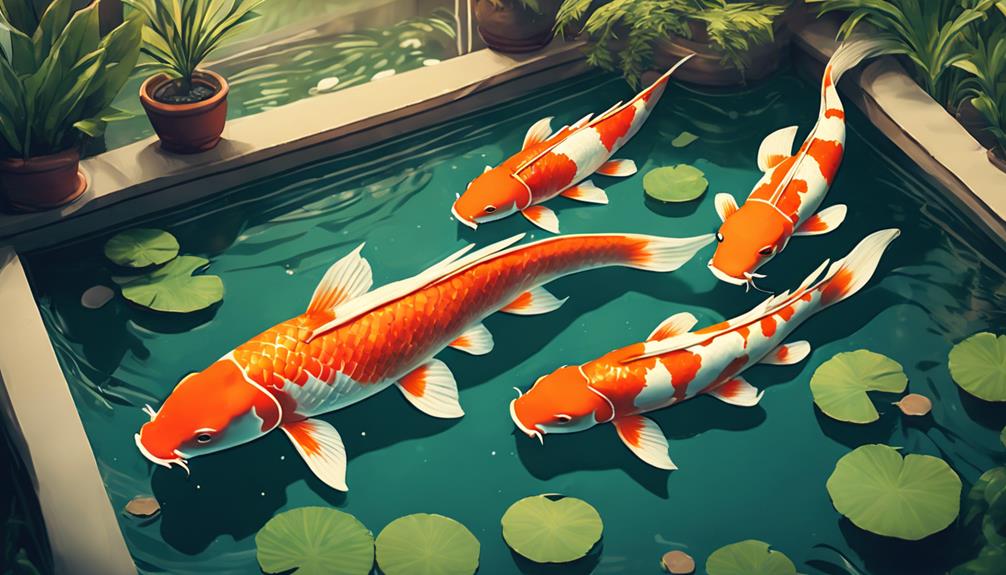
To guarantee successful breeding, dedicate a spacious, specially designed indoor tank or breeding container that provides each koi fish with at least 10 gallons of water and adequate hiding places, such as plants or rocks, to reduce stress and promote privacy.
This will provide a good spawning pond for your koi to thrive. Within your breeding set, verify you have a separate area for spawning, as this is vital for successful breeding.
Your koi's water needs are critical, so make sure the water is clean and gently circulated to provide peak oxygen levels. Aerated water is essential to provide a healthy environment for your koi.
By doing so, you'll create a stress-free space that encourages breeding. Remember, overcrowding can lead to stress, disease, and even death, so prioritize providing ample space for your koi.
Maintain Optimal Water Temperature
As you set up your indoor koi breeding system, it's vital to maintain ideal water temperature, which is critical to the success of your spawning and fry development.
You'll need to control the temperature within a narrow range to promote healthy growth and minimize stress on your fish.
Temperature Control Methods
You'll need to invest in a reliable temperature control system to maintain the ideal water temperature between 65°F and 75°F (18°C and 24°C) for your indoor koi breeding setup.
During the Breeding Season, it's vital to keep the water temperature consistent to create an environment to stimulate your koi's reproductive cycle.
A temperature control system will allow you to set a specific temperature range and automate the process, ensuring your koi are comfortable and healthy.
You'll want to check the water temperature several times a day, especially during the late afternoon when temperatures tend to fluctuate.
A reliable system will keep the water temperature stable, even when your breeding program is in full swing.
With a temperature control system, you can rest assured that your koi are thriving in an ideal environment.
This will give you peace of mind and allow you to focus on other aspects of koi breeding, such as water quality and nutrition.
Ideal Breeding Temperature
Maintaining a pivotal water temperature between 68°F and 72°F (20°C and 22°C) during the breeding season is vital, as it triggers the reproductive cycle in koi. This ideal breeding temperature range allows you to stimulate the fish, encouraging them to breed.
Male koi are more sensitive to temperature changes, so maintaining a consistent temperature is imperative to stimulate their reproductive cycle. Female Koi, on the other hand, are more tolerant of temperature fluctuations.
Years of experience have shown that breeding koi within the ideal temperature range increases the likelihood of successful spawning and healthy offspring.
Precision is key: even slight temperature deviations can affect the breeding process, so monitoring your water temperature closely is necessary to achieve ideal results.
Temperature Fluctuation Risks
Fluctuations in water temperature can have devastating consequences for koi breeding, making it crucial to regulate the temperature within the ideal range to prevent stress, disease, and breeding failure.
As a koi breeder, you should be aware that even a slight temperature fluctuation of 1-2°C can cause stress to your koi, making them more susceptible to disease and reducing their fertility.
To promote healthy breeding and spawning, you should maintain a consistent water temperature between 17°C to 26°C, with an ideal range of 20°C to 22°C.
Temperature fluctuations can also affect the development of koi eggs, with temperatures below 15°C or above 28°C causing abnormal development or death.
A sudden change in water temperature can trigger spawning, but this method isn't recommended as it can cause stress and reduce fertility.
Ensure a Balanced Diet for Breeding
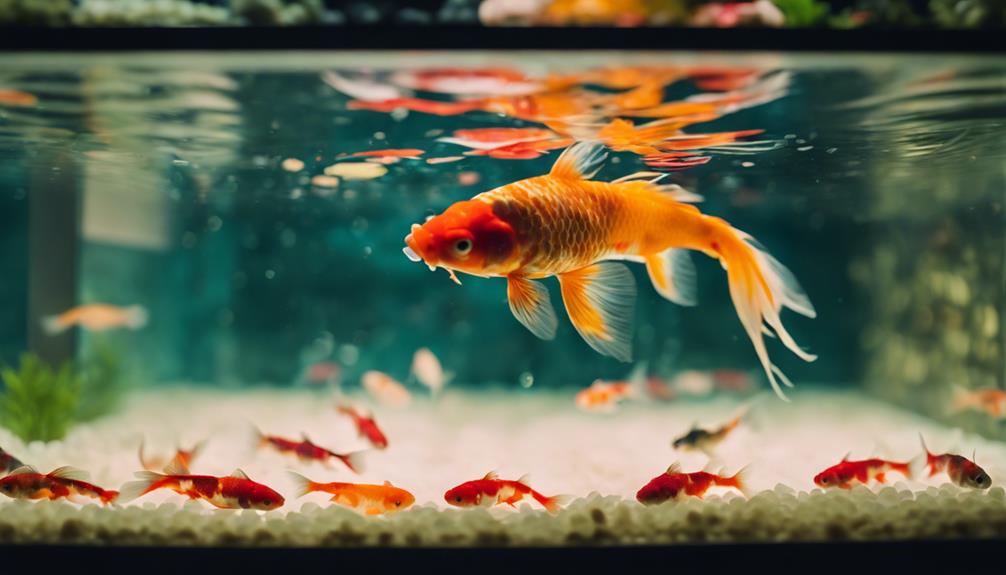
To foster a successful breeding program, you need to prioritize providing your koi fish with a balanced diet that meets their nutritional requirements for peak health and reproductive performance. A well-fed koi fish is more likely to thrive and produce healthy offspring.
When it comes to feeding your koi fish, you should:
Feed them at least 4 times a day with high-quality fish food to provide energy for breeding.
Offer a varied diet that includes live or frozen foods, such as brine shrimp or bloodworms, to provide essential nutrients and stimulate breeding.
Consider adding supplements, such as spirulina or krill, to the koi fish's diet to enhance their overall health and breeding performance.
Remember to avoid overfeeding, as this can lead to poor water quality and health issues. Monitor your koi fish's appetite and adjust feeding accordingly.
Install a Reliable Water Filtration System
With a balanced diet in place, you're now ready to focus on creating a healthy environment for your koi fish to thrive, which begins with installing a reliable water filtration system that can efficiently remove waste products and excess nutrients.
This system is vital in a koi breeding setup to maintain peak water quality and prevent disease outbreaks.
A good filtration system should be able to remove ammonia, nitrite, and nitrate from the water, as well as excess food and waste particles.
Make sure the system is designed to handle the specific water volume and flow rate of your breeding tank, with a minimum turnover rate of 10-15 times per hour.
Regular maintenance, including cleaning and replacing filter media, is essential to guarantee the system's effectiveness.
Consider adding a UV sterilizer to control algae growth and prevent disease-causing bacteria and viruses from multiplying.
Monitor Water Quality and Make Adjustments
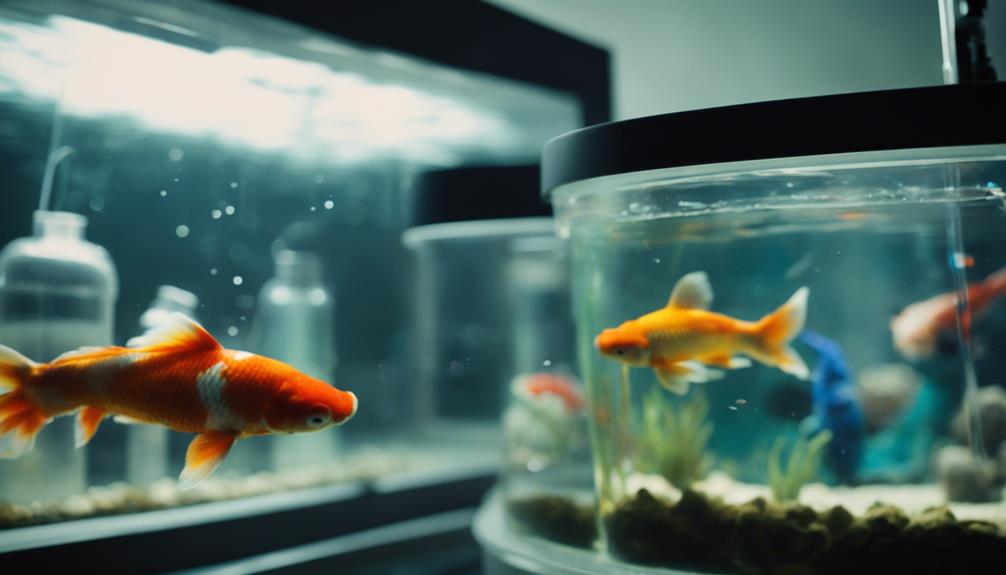
As you closely monitor the water quality in your breeding tank daily, you'll be able to detect even slight changes in ammonia, nitrite, and nitrate levels, guaranteeing a healthy environment for your koi. This daily monitoring allows you to make adjustments before any issues become severe.
Regular water changes of 10-20% every week are vital to maintain peak water quality and prevent disease. Additionally, you should check the pH level, which should be between 6.5 and 8.5, as sudden changes can stress the koi and lead to illness or death.
Maintain a consistent water temperature between 65°F and 75°F to prevent stress and illness in the koi.
Verify your breeding tank is equipped with a reliable water filtration system, such as a biological filter, to remove waste and toxins from the water.
Be prepared to make adjustments to your water quality management strategy as needed, based on the unique needs of your koi and the specific conditions of your breeding tank.
Provide a Safe and Clean Spawning Area
You'll need to prepare a dedicated spawning pond that's specifically designed to promote successful breeding.
This involves creating an environment that's free from stressors and provides ideal conditions for your koi to spawn.
Spawning Pond Preparation
Set up a dedicated spawning pond that provides a safe and controlled environment for your koi to spawn, carefully designing it to meet the specific needs of this critical process.
To guarantee success, consider the following essential factors:
- Create a small pond with an area of 6 to 12 square meters and a depth of about 50 centimeters to provide a comfortable space for your koi to spawn.
- Fill the pond with un-chlorinated water to prevent any contaminants or toxins from affecting the spawning process or the health of your koi.
- Provide a generous amount of spawning material, such as synthetic spawning ropes or mats, to encourage the female koi to lay her eggs and to give the male koi a surface to fertilize them.
Additionally, guarantee your spawning pond is equipped with a reliable aeration system that maintains good water quality and prevents stress to your koi.
The system should be designed to prevent water turbulence during aeration, allowing your koi to spawn peacefully.
Egg Incubation Environment
To guarantee the successful incubation of koi eggs, create a safe and clean spawning area by maintaining a small, well-aerated pond with a controlled water temperature.
This means setting up a pond that's around 6-12 square meters in size, filled with un-chlorinated water to a depth of about 50 centimeters. You'll also need to add a generous amount of spawning material, such as synthetic spawning ropes, to encourage the female koi to lay her eggs.
Next, verify the pond is sufficiently aerated at all times with strong but silent air pumps. This will maintain water quality and promote healthy spawning.
It's vital to maintain a water temperature between 15-20 degrees Celsius to optimize egg incubation and development. By creating this ideal environment, you'll increase the chances of successful egg incubation and give your koi the best start in life.
Manage the Breeding Process With Care
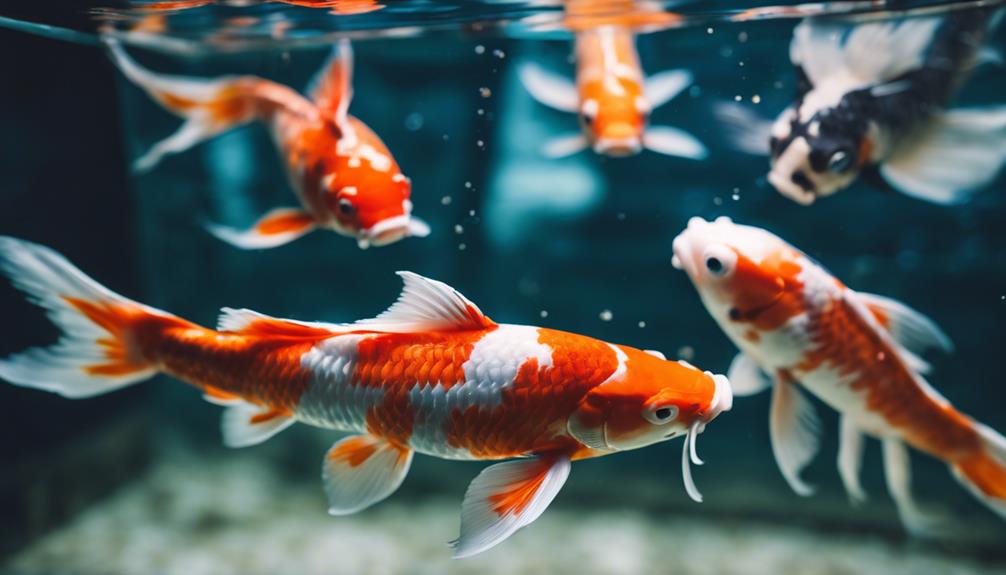
By carefully controlling the breeding environment, you can substantially increase the chances of successful spawning and reduce the risk of disease or injury to your koi fish.
To breed specific varieties, you need at least a pair of healthy koi fish that are at least 3 to 6 years old. Select well-fed parents with non-metallic scales, such as Sanke, to guarantee the koi fry inherit the desired traits.
Provide a suitable breeding environment by placing the male and female koi fish in the same pond or tank, guaranteeing the space is large enough to accommodate them comfortably.
Maintain a suitable temperature for breeding between 17 to 26 degree Celsius and install a reliable water filtration system to keep the water clean.
Certify the koi fish are well-fed before, during, and after breeding, providing a balanced diet that includes essential nutrients for healthy breeding.
Be Patient and Monitor the Results
You've invested time and effort into creating an ideal breeding environment, and now it's time to let nature take its course, while keeping a watchful eye on the process to guarantee successful spawning.
Breeding koi requires patience, and crucially, you must monitor the results to identify areas for improvement. Regularly check the water quality, koi health, and breeding progress to catch potential issues early on.
This allows you to make adjustments and optimize breeding outcomes. Keep accurate records of your breeding attempts, water quality, and koi health to track progress and make data-driven decisions.
Being patient and monitoring results enables you to refine your techniques and eventually achieve your desired breeding goals. Remember, breeding koi is a process that takes time, effort, and resources.
Frequently Asked Questions
How to Breed Koi at Home?
You'll successfully breed koi at home by setting up a suitable environment, testing water quality, designing a breeding tank, selecting the right koi, preparing a spawn tank, controlling water temperature, and planning a nutritious diet for your fish.
What Should You Do First Before Attempting to Breed Koi?
"Imagine the thrill of breeding koi! Before you start, you'll need to prioritize koi selection, tank preparation, water testing, and the cycling process, ensuring a reliable filtration system and quarantine process, all backed by thorough research."
How to Encourage Koi Spawning?
To encourage koi spawning, you'll want to guarantee koi maturity, maintain water stability, and introduce spawning triggers like temperature changes or water flow.
How Do You Get Koi to Release Eggs?
You optimize spawn timing by simulating environmental cues, like shallow water and gentle aeration, while controlling water temperature (18-25°C) to encourage egg release, considering factors like koi age, egg quality, and parental selection to reduce fish stress.
Conclusion
You've successfully set up your indoor koi breeding program, but don't think it's going to be a walk in the park.
Anticipating potential setbacks, like high mortality rates, is vital.
One common concern is that indoor breeding will lead to weak or deformed offspring due to lack of natural selection.
However, with careful monitoring and control of water quality, temperature, and diet, you can mitigate these risks and produce healthy, thriving koi.
Stay vigilant, and your patience will be rewarded with a thriving brood.

